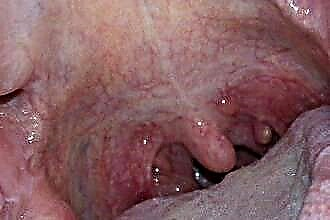Traditional medicines are indispensable helpers during the treatment of maxillary sinusitis. Many plants have anti-inflammatory, anti-edematous, antiseptic effect and significantly alleviate the patient's condition. Sometimes they are able to partially substitute for pharmacological drugs. Kalanchoe is very popular among the people for sinusitis.
Useful properties and composition of the plant
 More than 200 species of Kalanchoe are known in nature, growing mainly in tropical climates. They belong to succulents, have fleshy juicy leaves and stems. Not all of them have healing properties. Some species of this plant are kept by people on the windowsills of the house as a decorative flower and a first-aid kit. For medical purposes, 2 types of plants are used:
More than 200 species of Kalanchoe are known in nature, growing mainly in tropical climates. They belong to succulents, have fleshy juicy leaves and stems. Not all of them have healing properties. Some species of this plant are kept by people on the windowsills of the house as a decorative flower and a first-aid kit. For medical purposes, 2 types of plants are used:
- Kalanchoe degremona with a large number of small daughter plants at the edges of the leaves;
- Kalanchoe pinnate, fresh shoots of which, after laboratory studies, were officially recognized as a raw material for the preparation of medicines.
Treatment of Kalanchoe sinusitis has been widespread since ancient times in different parts of the world (China, India, Africa). People have noticed that the leaves and stems of this flower have healing properties for diseases of the upper respiratory tract (runny nose, sinusitis), bowel diseases, stomatitis, periodontitis, otitis media and skin burns. This is due to the presence of a number of useful natural substances in them, such as:
- mineral salts and flavanoids;
- polysaccharides;
- vitamins C, E, A and tannins;
- acids (oxalic, acetic, citric and malic);
- macro- and microelements (copper, manganese, calcium, iron).
Due to such a rich chemical composition, Kalanchoe with sinusitis has an antibacterial, antiviral, wound healing and anti-inflammatory effect.
The use of preparations based on plant juice helps to evacuate purulent accumulations from the sinuses, reduces tissue edema and stimulates the strengthening of local immunity.
Rules for the preparation, storage and use of Kalanchoe juice
The basis for the preparation of most drugs for sinusitis (chronic or acute) based on callanchoe is its juice. To achieve the maximum effect, you need to harvest it correctly:
- the cut plant is kept for a week in a cool, dark place;
- leaves and stems are crushed with a knife, and then ground to a puree state;
- the resulting slurry is filtered through several layers of gauze and left for 2 days to precipitate;
- pure juice is carefully drained and diluted with medical alcohol at a concentration of 20: 1.
- you can dilute the resulting drug with water 1: 1 immediately before infusion into the nose, so that the effect on the mucous membrane is less pronounced.
The patient does not always have time to carry out all the long-term manipulations. In this case, you can simply  squeeze fresh juice from the leaves, keep in a cold place for 24 hours and dilute with alcohol. Such a drug is stored in the refrigerator for no longer than a week, the best option is 2-3 days. Freshly squeezed juice also has a good effect in allergic sinusitis, but it should be used immediately, and a new one should be prepared for the next procedure.
squeeze fresh juice from the leaves, keep in a cold place for 24 hours and dilute with alcohol. Such a drug is stored in the refrigerator for no longer than a week, the best option is 2-3 days. Freshly squeezed juice also has a good effect in allergic sinusitis, but it should be used immediately, and a new one should be prepared for the next procedure.
It is necessary to instill 1-2 drops in each nostril four times a day. In this case, it is better to lie with your head turned to one side. The components of the drug irritate the receptors of the mucous membrane, so after a couple of minutes a violent reflex sneezing begins, which can last up to 15 minutes. During this process, mucous accumulations from the nose and paranasal chambers are released, restoring aeration and drainage of the sinuses, as well as nasal breathing. The disadvantage of this method is the short duration of the therapeutic effect.
When treating children, the resulting preparations should be diluted with boiled water (1: 3). You should also supervise your child after instilling the medication, because if he sneezes uncontrollably, he may hit his head on the sharp edge of the table or other furniture.
Other uses of the herb to treat sinusitis
Alternative medicine offers various uses for callanchoe components, often in combination with honey or other herbal remedies. The following recipes have proven themselves well:
- Rinsing the nose. An alcoholic tincture is preliminarily prepared. 2 tablespoons of finely chopped stems and leaves are poured with 200 ml of 40% vodka and infused in a dark place for 10 days. The tincture is used to rinse the nose, for this you need to pour a teaspoon of it into 150 ml of boiled warm water. Rinse the nasal passages 3 times a day.
- Nasal drops. Equal volumes of freshly squeezed callanchoe and aloe juice are brought together, after which baking soda is added on the tip of a spoon and 5 g of bee honey is added. Pour the resulting liquid into the nostrils three times a day, 3 drops.
- Ointment. Combine lanolin and petroleum jelly (50 ml each) from the pharmacy with 30 ml of plant juice and mix until a homogeneous emulsion is formed. The ointment is moistened with gauze turundas or cotton swabs and inserted into the nasal passages for 5-7 minutes. Three reps daily is enough. Instead of petroleum jelly and lanolin, you can use more potent Levomekol or Vishnevsky's ointment
- Endonasal lotions. Combine equal parts of onion juice, Kalanchoe, cyclamen and aloe, as well as honey. The resulting liquid is soaked in cotton swabs and inserted into the nostrils twice a day for half an hour.
- Aromatherapy. Chop a few fleshy leaves into pieces and place them on a plate at the head of the patient's bed overnight. Actively stand out
 phytoncides for several hours will destroy viruses and bacteria, having a healing effect on the body.
phytoncides for several hours will destroy viruses and bacteria, having a healing effect on the body.
If you use such phytopreparations in combination with antibiotics, starting from an early stage of the disease, you can avoid the transition of the disease into an acute purulent form. Unpleasant symptoms of illness such as congestion and headache will be less severe. The use of traditional therapies helps to enhance the effect of drugs and shorten the treatment time.
Contraindications and application features
Biologically active components of Kalanchoe can in some cases have an undesirable effect on the patient's body. Such herbal medicine is contraindicated in the following conditions:
- individual intolerance to the constituents of the plant;
- allergic reaction.
Before using alternative medicine recipes, you should consult an otolaryngologist. The first intake of a plant-based medicine should be done by diluting it with additional water and carefully observing the patient's reaction. If warning signs begin to appear (rash, itching, redness of the skin, nosebleeds), then you need to immediately interrupt the procedure, rinse your nose with clean water, take any antihistamine (Loratadin, Cetrin, Diazolin) and go to the hospital.
Care should be taken to use Kalanchoe-based products for pregnant women, since irritating ingredients lead to frequent reflex sneezing and can cause uterine contraction. For women who are breastfeeding, topical application of the herbal remedy will not hurt.
For children under the age of three, it is better not to drip preparations based on the tincture of the plant at all, so as not to burn the mucous membranes.
In the treatment of sinusitis in children over 3 years old, it is more advisable to use not an aggressive tincture of the plant, but a decoction of the leaves, which acts softer and will not harm the child.To prepare the broth, you need to fill in finely chopped 2-3 leaves with 100 ml of boiling water and leave in a thermos for about an hour. Instill 2 drops into the child's nose three times a day, having previously filtered through cheesecloth or a sieve. You can simply lubricate the inner walls of the nose with a moistened cotton swab on a stick.

 phytoncides for several hours will destroy viruses and bacteria, having a healing effect on the body.
phytoncides for several hours will destroy viruses and bacteria, having a healing effect on the body.

